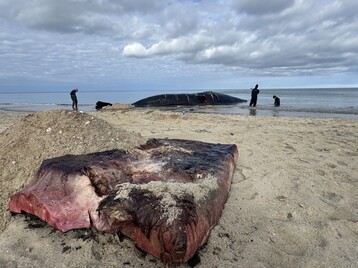Exam Could Yield Clues To Sperm Whale's Cause Of Death
Jason Graziadei •
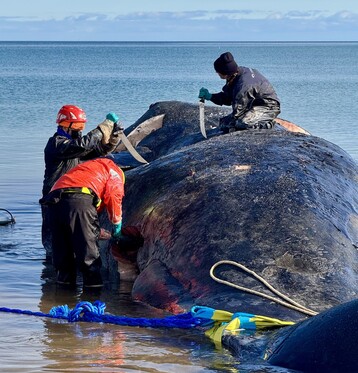
The stench of a decaying, 50-foot sperm whale filled the air at 40th Pole beach on Friday, hours before the carcass was towed out to sea by the tugboat Lucinda Smith. While most people kept their distance, Dr. Sarah Sharp and Dr. Charles Innis not only ventured on top of the massive cetacean, but also cut holes into its body and reached inside.
Sharp and Innis were among a team of marine mammal experts who traveled to Nantucket last week to perform what is called a "window exam" of the deceased sperm whale to gather as much information about the animal as possible and, potentially, determine the cause of its death.
While they had hoped to conduct a complete necropsy, that would have required transporting the 104,000-pound carcass to another location, and it was determined it was simply too large. But the window exam, which allowed them to evaluate an old wound on the whale's back and some of its major organs, may still yield clues as to what may have caused the apparently healthy whale to die and wash up on Nantucket's north shore.
"So we were able to do a couple of different windows, or kind of small areas where we can cut into the whale and examine the tissues and the organs that are deep there," said Sharp, an animal rescue veterinarian with the International Fund for Animal Welfare (IFAW). "We were able to examine the wound that everybody has kind of seen on the dorsal aspect of the back of the whale. And so we're able to cut into that and examine that a little bit more thoroughly as well. We took a number of samples for histology, and so we'll bring those back and send those off to a veterinary pathology lab for further analysis."
IFAW animal rescue veterinarian Dr. Sarah Sharp explained how her team completed what is known as a “window exam” on the dead sperm whale on Nantucket which allowed them to take samples and inspect some of its major organs. pic.twitter.com/nN6ech8PyG
— Nantucket Current (@ACKCurrent) November 24, 2025
While the wound on the sperm whale's back was immediately noticeable to all who ventured out to see the carcass - and led to speculation that a ship strike may have caused its death - Sharp said the examination showed it was an old wound and in all likelihood did not contribute to its demise.
"We didn't see a very obvious cause of death," Sharp said. "There was certainly evidence of that wound that was there being a chronic wound, so it was a lot of scar tissue that had built up over time. There was also a few other areas of, kind of discoloration around that wound, and a little bit of a pocket of infection there. But none of what we saw looked like it obviously caused the animal's death. So we will be waiting on the results of the lab for a cause of death determination."
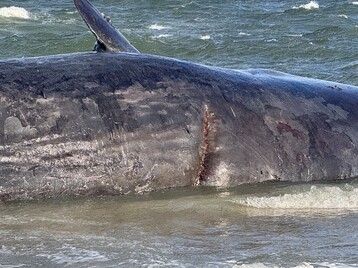
While they were unable to determine the whale's age during the exam, Sharp said it appeared to be a middle-aged male in good health.
"He was in pretty good body condition," Sharp stated. "There was evidence that he had been feeding fairly recently, so he had a decent amount of feces in his colon. And so nothing that screams a chronic illness to me. And then, again, that wound, it's been there for a while, given all of the scar tissue that was there, it certainly wasn't a new thing."
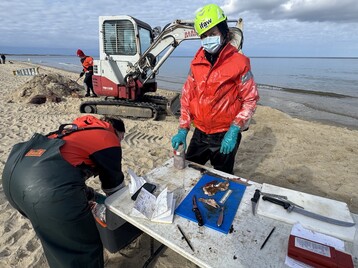
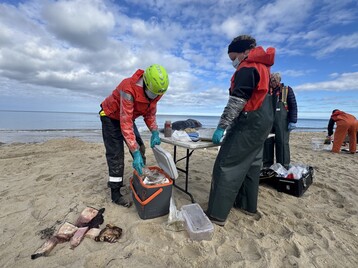
During the window exam, Sharp and her team removed pieces of blubber around the wound to check for evidence of fractures to the ribs or the vertebrae, but found none. Small samples of its major organs, including its heart, lungs, intestines, stomachs, colon, and liver, were also taken for further examination by the lab. The team also made a point of examining the whale's stomach chambers to see if it had ingested any plastic debris or other ocean trash.
"We were trying to prioritize looking for that," Sharp said. "We weren't really able to open up all of the stomach chambers, but we looked at what we could, we palpated around into the stomach chambers, and didn't feel anything obvious, like a plastic ingestion or a blockage. And the presence of feces also indicates to me that there wasn't any complete blockage of the GI, so even if he had ingested some plastic and that got into his stomach, it wasn't like he wasn't passing things. So nothing obvious there. It's certainly something that was on our radar."

